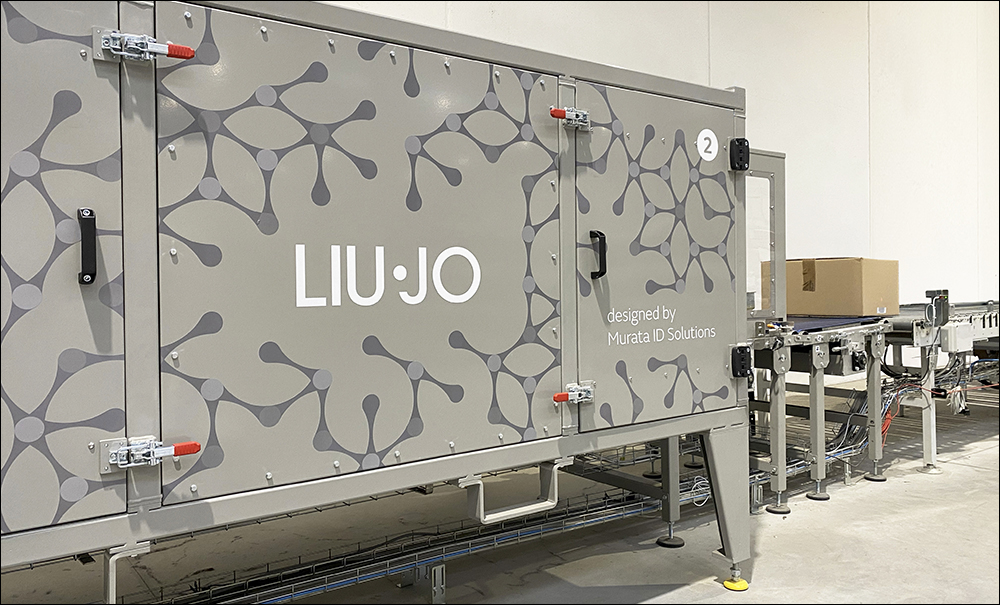Italian fashion brand Liu Jo is targeting the gray market with a radio frequency identification solution that tracks goods through its distribution center. By capturing RFID tag reads of inbound and outbound goods, the company reports that it has boosted efficiencies and raised inventory accuracy, while also targeting unauthorized sales of its products.
The fashion company was founded in Carpi, Italy, in 1995 by brothers Marco and Vannis Marchi. These days, Liu Jo has stores selling its branded goods throughout the world. Its products include women’s, men’s and children’s apparel, as well as handbags and accessories, such as jewelry and watches. The company opted to deploy an RFID solution from Murata ID Solutions for two reasons: to battle the gray market and to gain efficiency in logistics and achieve greater accuracy.

Liu Jo is targeting the gray market with RFID.
Brands have been challenged for years by gray market sales, the unauthorized diversion of goods from authorized channels into the hands of third parties. Such sales pose a risk to original equipment manufacturers’ brands and have thus been a bane to many product makers, according to the Alliance for Gray Market and Counterfeit Abatement. The first line of defense for many is to control the distribution system, and that means boosting visibility into every item moving from the point of manufacture to an authorized store.
RFID Visibility Enables BOPIS
The growth of omnichannel sales, in which shoppers purchase goods online and pick them up at the nearest stores (also called “BOPIS”), or request shipments directly to their homes, has made supply chain visibility increasingly important. While looking into methods for addressing both gray markets and efficiency, the company chose RFID technology, according to Carlo Del Stabile, Liu Jo’s chief operating officer. “RFID enables the product’s electronic pedigree, which is the logistics history of the single product that can be verified and controlled at any moment,” he explains, ” informing about the product’s origin, destination and steps throughout the supply chain.”

Murata’s ID Solutions’ customized UHF RFID tunnel gate
While seeking to combat the gray market, the company also wanted to leverage the technology to reduce complexity in logistics operations, as well as optimize inbound and outbound processes. Beyond that, Del Stabile says, Liu Jo intended to minimize labor and, above all, increase inventory accuracy. The company already had some background in RFID technology, with what Del Stabile calls some “sporadic experiences in the past, but without really satisfying results.” In late 2021, however, the company opted to deploy the RFID solution at its primary distribution center in Rolo, a commune in Northern Italy. The system was taken live in October 2021.

Carlo Del Stabile
The system consists of Murata’s ID Solutions’ customized UHF RFID tunnel gates and id-Bridge 4.0 RFID software suite for the automatic identification and verification of tagged items, says Laura Pellegri, the company’s RFID project manager. Liu Jo initially applied passive UHF RFID tags to all accessories in its spring and fall 2022 collections, including bags, belts, wallets and scarves. Since the system was taken live, third-party manufacturers have been applying the tags to the products, such as necklaces and bracelets, before shipping them to Liu Jo’s distribution center.
The ID number encoded on each tag is linked to details related to the corresponding product in the software, creating a unique digital identity. As goods are received in shipping boxes at the Rolo DC, each box of goods is placed on a conveyor that passes through the Murata high-capacity RFID tunnel reader. As the box travels through the reader, all tags are interrogated, and the data is updated in the id-Bridge software as being received. The software compares the tag reads with the list of expected goods, thereby confirming that no products have gone missing before arriving at the DC. If a problem is detected, an alert is displayed and an operator can manually check the indicated boxes.

Laura Pellegri
Next, as goods are shipped to stores from the DC, they are packed according to orders and pass through a second tunnel reader. In that way, the tag reads confirm that the appropriate items have been packed and are destined for the authorized store. If a product is missing from the shipment, or if an erroneous tag read is captured, the software flags that event so operators can review the error. On the other hand, if the order matches the shipping list, either at the receiving or shipping side, the system displays a green light to proceed.
The id-Bridge software, residing on a Web-based platform, enables end-to-end management of RFID systems at any scale for retailers and brands, the company reports, including for proof-of-concept projects. For the Liu Jo deployment, Murata integrated its software with the brand’s inventory software. As a result, says Grethe Bonde, Murata’s marketing communications specialist, “Thanks to the information they have about every item, they are actually able to link every item to the destination market.”
RFID Deployment with Room to Grow
In addition to the readers and software, Bonde adds, Murata provided tag selection support to determine the appropriate tags for this use case. The technology has been deployed only at the logistics site so far, rather than in stores. While the solution began at the DC with two tunnel readers, Pellegri says, the company may opt to deploy additional tunnel readers in late April to accommodate more products.

Grethe Bonde
For Liu Jo, the system provides verification and identification of each shipment before it leaves for “the last mile” to the store. What’s more, the software provides a historic record of each item’s movement through the distribution site. If something goes wrong, such as an item appearing in the gray market, the company has a better understanding of what may have occurred, or where the product was diverted.
Murata customized the tunnel readers used at the DC to suit the dimensions and volume of boxes handled there. The tunnel readers can capture tag reads from up to 300 items inside each box within a matter of 10 seconds, Pellegri says, and read accuracy is near 98 percent. To date, Del Stabile adds, the technology has helped Liu Jo increase its efforts in combatting the gray market, and it has “allowed us to significantly speed up the logistics processes and gain a very high accuracy of the products shipped.”
The solution has also reduced the amount of manual work required, Del Stabile reports, while digitizing the logistics operations. “Thanks to RFID,” he states, “every single product can be uniquely identified and, most importantly, [be] linked to its destination market, trimming down unfair gray-market practices.” Starting with the spring/summer 2023 collection, the system will be scaled to apparel, he says, and going forward the company hopes to determine what the next steps will be for RFID use.
Key Takeaways:
- Digitizing accessories and gaining an automated view into their movement is reducing manual work for employees and preventing errors.
- With the RFID deployment, Liu Jo can prevent goods from ending up in the gray market.
Exhibitors at RFID Journal LIVE! 2022 will offer RFID tagging solutions designed to target the grey market and boost efficiency. To learn more, visit the event’s website.

